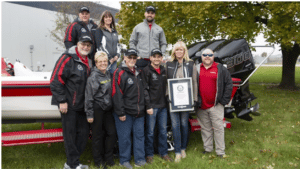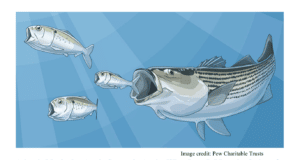One issue in the Florida Keys is that sea-grass flats are poorly marked, and without both careful observation and extensive local knowledge, grounding seems almost inevitable. Here are some tips for avoiding the problem.
1. Green, green, go, go. Brown, brown, run aground. Grass flats look brown in bright light, so avoid those areas. Deep water is green or blue.
2. Don’t boat after dark in treacherous waters. Look across Florida Bay and it’s unlikely you’ll see more than a couple of commercial fishers anywhere in eyesight. Guess why.
3. Some shallow flats are marked with white and orange hazard buoys or diamond-shaped warning signs.
4. Never leave the dock without a chart.
5. Accurate GPS charts are so helpful in avoiding a grounding that we don’t see how boaters in areas of shallow flats can enjoy boating without them. Consider the cost of even a handheld unit at around $200 vs. the restoration cost of thousands of dollars in case of a grounding — plus a ticket. Which is cheaper?
6. If you do run aground, report it to the Coast Guard or local wildlife management authorities. Failure to do so could lead to a citation or even a felony indictment for “leaving the scene of an accident.”
If you run aground, Kiel Johnson of the SeaGrass Grow campaign will likely be called to fix the mess. I got to assist him on a restoration project in Everglades National Park three miles from World Wide Sportsman. World Wide Sportsman and Columbia funded the project.
On our arrival, Kiel’s boat and two other volunteer craft were quickly anchored near a grass flat crisscrossed with white stripes — the telltale sign of wayward navigators. Through dive masks we peered at the 100-yard-long prop cut, and it was clear that once the grass was dislodged, current had scoured the bare sand deeper and deeper until the edges of the scar caved in, widening the injury. If nothing is done, thousands of square yards of turtle grass could be lost to erosion.
Kiel got to work quickly, enlisting volunteers and even editors.
First, he and his crew hoisted five-foot-long tubular sandbags to wading volunteers. The sand inside is consistent with the natural sand. Laying two bags side by side filled our project scar. Only 40 more bags to go.
Next, steel staples were hooked through strands of shoal grass and pinned to the sandbags.
Finally, seabird perches were staked out all along the replanted scar so birds could roost there and do what birds do. That “doing” begins the nutrient cycle, allowing the grass to take root.
“In a few weeks, much of the shoal grass will be rooted in the sandbags,” he said. “As the sand becomes saturated with nutrients, the bags will rot away and the shoal grass will hold the sand in place. Eventually, we’ll see the turtle grass take root and displace the shoal grass, bringing the flat back to its original natural state.”
Not a bad ending to a story — unless you’re uninsured!









